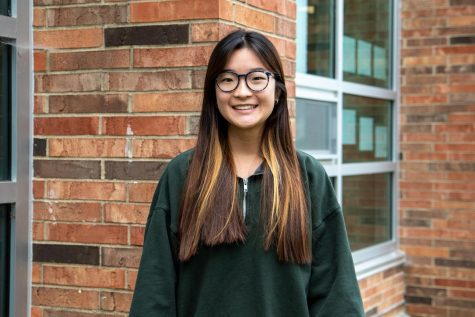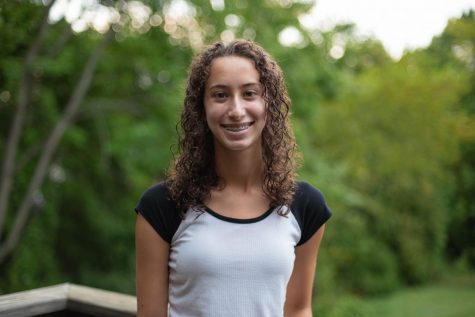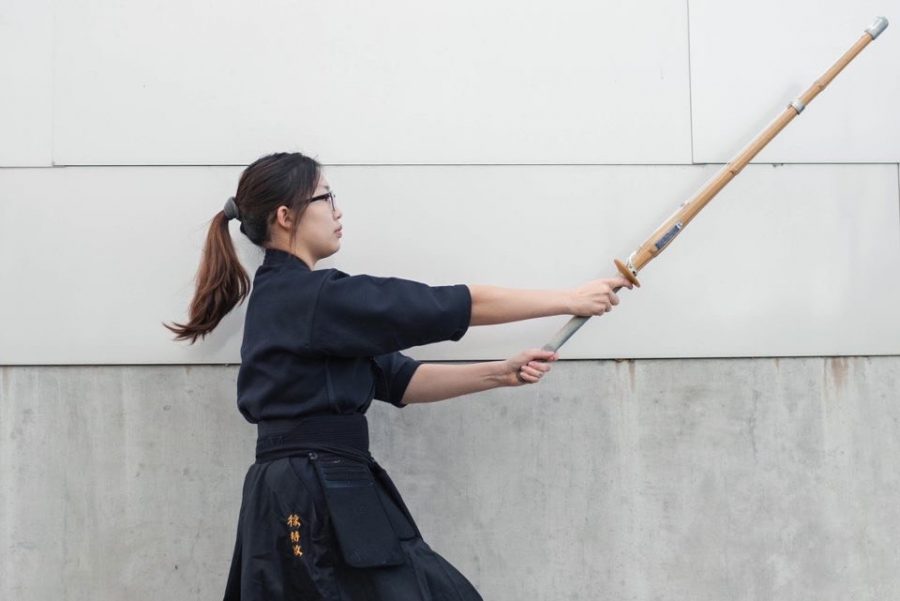Bonding through swords
Jimin Seo ’22 recounts her journey through mastering the art of kendo with the help of her dad as her coach.
Jimin Seo ’22 casts her bamboo sword forward as she stretches her arms to perform her strike.
Peering through the iron bars stretched across her mask, she takes one look at her opponent as she prepares her next strike. Sweat drips down her face as her gloved hands tightly grasp the sleek bamboo sword. With an ear-splitting scream, she thrusts her sword downward rapidly, striking the opponent on the head and crowning her victory. Though her attacks are fierce, her last move always ends with a graceful bow. This sequence of movements, however, did not always come easily to Jimin Seo ’22, a kendo martial artist.
Jimin was only nine years old when she first stepped into the dojo where her dad trains and coaches kendo. The resounding shouts and clashing sounds of the wooden swords carried through the room, drawing her attention towards two men draped in dark armor.
“I saw my dad and his co-instructor start with a bow, but the second they started sparring, they were screaming and yelling while hitting each other. I was really shocked,” Jimin said. “It looked really chaotic, but it seemed like they were cautious and respected each other’s space at the same time.”
After tagging along to several more practices with her dad, Jimin was still astonished by the powerful yet sophisticated nature of kendo. When she attended her first official class, she quickly developed a fascination for the sport.
“When I first started kendo, it was really different because I’d never done anything like it before. My dad took me along to one of his practices and after watching him, it seemed really interesting. During my first few practices, I would slide and play around with the swords. That’s when I started to gain interest in it,” Jimin said.
Jimin’s dad, Bongchul Seo, began his kendo career in college in South Korea and practiced almost four hours daily. A few years later when he moved to the United States, he continued to pursue kendo as a co-instructor for the kendo club at the University of Iowa. He started to teach his own two daughters, Jimin and Lucy Seo ’25, for numerous years after that. Bongchul explained that mastering the art of kendo requires two important skills: determination and perseverance.
“Jimin struggled at first because kendo is a hard sport to master the basics and improve all at once. But every single practice, she always gave it her all, even if she didn’t want to go,” Bongchul said. “She would always get her uniform and her armor on quickly and would be the first one in line to spar. I believe she learned to persevere and grow from that.”
Starting out slow, Jimin’s father taught her the foundations of kendo, from classic etiquette and technical terms to beginner sword positions.

“It was really nice to have my dad as a teacher especially at the beginning because I was a shy kid growing up and felt comfortable around him. He would take me a few times a week and just teach me the basics,” Jimin said. “I picked it up pretty quickly, and after that, he started taking me along to regular classes.”
As she advanced out of beginner classes, practices became increasingly difficult. For Jimin, mastering new skills grew harder and more technical than ever. The heavy iron and thick leather armor made the heat unbearable. Every movement was expected to be precise and the transitions had to be seamless.
“It is just such a hard and sweaty sport, especially because you have to keep your posture really straight,” Jimin said. “You also have to be cautious to not hurt the opponent and pay a lot of attention to every move you make. Some postures were difficult to even keep stable.”
Despite the demanding and strenuous circumstances, Jimin says having her dad as her coach played a large role in her passion and improvement in the sport over the years.
“My favorite moments while practicing kendo was when my dad would give me small compliments during my sparring matches,” Jimin said. “He usually did not give out many to his students, but when he did, those were some of the best moments that kept me confident in myself.”
In addition to developing into a more diligent and hardworking athlete, Jimin described that the best part about practicing kendo was the quality time she would spend with her dad and sister at the gym.
“After doing kendo with my dad every week since I was really young, it tightened our bond because we had that connection with each other. We practiced with my sister Lucy, and my mom would also come in to watch, which made kendo seem more like spending family time over anything else,” Jimin said.
Jimin’s younger sister, Lucy, also agrees that the best memories of kendo practice were the sister and family bonding they would all have together.
“Jimin and I were in different classes, but sometimes she would come to the beginner class. She would be in charge of teaching for the first 15 minutes, so it was funny to see her try to teach,” Lucy said. “Then after practice when we felt super refreshed, we would end the day by getting food or going out for ice cream as a family.”
While her enthusiasm for the sport initially drew her in, the family ties behind kendo helped solidify her passion for the sport. Despite the arduous hours spent on perfecting every move, the time spent making memories with her family was what made her experience truly unforgettable.
“Kendo is just something that is really meaningful and unique to me. Starting with my dad and him teaching my sister and me, it was all just an experience that was never questioned or would ever leave our family,” Jimin said. “It is just a special thing that bonds and holds us all together.”
Your donation will support the student journalists of West High School. Your contribution will allow us to purchase Scholarship Yearbooks, newsroom equipment and cover our annual website hosting costs.

(she/her) Soomin Koh is a senior at West, and it is her second year on print publication staff as a co-profiles editor. In her free time,...

(she/her) Caroline Barker is a senior at West. This is her third year on staff, and this year is the photo editor for the print publication. Outside of...




